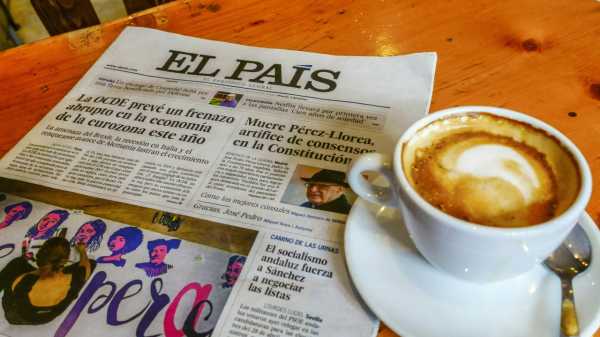
Save this storySave this storySave this storySave this story
El País, arguably the most prestigious Spanish-language news organization of the past half century, and whose slogan is “The Global Newspaper,” has just made one of the more seemingly obvious moves in its history: it opened a national newsroom in one of the largest Spanish-speaking countries in the world—the United States. As logical as this might sound, this new market was out of its reach for a long time, not least because El País had to wait for it to actually develop.
El País U.S., a Spanish-language digital news site, launched in May with a newsroom of fifteen journalists based across the country, and is seeking full-time reporters and freelancers in New York, Florida, Texas, and California. The managing editor, Inés Santaeulalia, said that the timing was meant to capitalize on the crucial role of the thirty-six million Latinos who are eligible to vote this November. “The electoral year is key to us,” she said. “We decided to launch before the summer to position ourselves ahead of the elections. It will be a moment of great political attention from the Latino population and the entire country, due to the strength of their vote.” Indeed, the site’s first issue was dedicated to this subject; it explored the reasons behind the disillusionment of so many Latinos with Joe Biden, who “did not fulfill” promises important to them, and their growing support for Donald Trump, despite his pledge of record mass deportations. But El País U.S. is also covering Latino angles on the topics that are of most importance to all Americans, such as guns, with a focus on the disproportionate impact of gun violence on Latino communities, and the campaign of Kamala Harris, focussing on how the story of her immigrant parents resonates among Latinos.
El País is owned by PRISA Media, a transnational conglomerate with major interests in Spain and the Americas, whose holdings include a textbook publisher, a network of Spanish-language radio stations across Latin America, and other newspapers. In what might be an overly optimistic appraisal, at a shareholder meeting in June, Carlos Núñez, PRISA’s executive chairman, estimated a potential audience of sixty million people for El País U.S. That’s about the size of the entire Latino population, many of whom are not Spanish speakers. (El País has offered English translations of selected digital stories for years, aiming to capture an international audience, but its focus remains on Spanish content.) Yet, according to the 2020 census, there are forty-two million native Spanish speakers in the U.S. (up from twenty-eight million just two decades ago), which makes it the fifth-largest Spanish-speaking country in the world. (Spain itself is fourth, according to the Instituto Cervantes.)
Spanish has long been the second most spoken language in the U.S. (one of only a handful of countries without an official language). And it is spoken by “a distinct language group that continues to replenish itself” owing to “persistent migration, which is the factor that sets Spanish apart from every other non-English language in the United States,” as Rosina Lozano, a professor of history at Princeton, wrote in “An American Language: The History of Spanish in the United States.” Though fifty-four per cent of Latino adults get their news mostly in English, according to Pew Research, there are still millions who prefer to consume the news in Spanish (twenty-four per cent of the total Latino population) or consume it in both English and Spanish (twenty-three per cent). El País U.S. is betting on those readers.
Spanish-language media has a long and rich history in the U.S.; it has played a fundamental role as an advocate for immigrants’ rights and often served as the only source of information for entire communities. In 2019, the last time the sector was mapped, in a project I led at the Craig Newmark Graduate School of Journalism, at CUNY, there were more than six hundred Latino news outlets in the country. These included the giant national TV networks Univision and Telemundo, dozens of radio stations, more than two hundred and forty print newspapers (most of them local), thirty-two magazines, and eighty-seven digital-only publications. Like the news industry at large, most of these newsrooms were dealing with declining audiences, and were still struggling to adapt to the digital age, with varying levels of success. The major national newspaper chain, ImpreMedia, the owner of the once great metro papers El Diario (New York) and La Opinión (Los Angeles), was consolidating content and laying off reporters. (The company has since been acquired by a private-equity-backed startup.) Despite its size and importance, the Spanish-language media sector has long been seen as foreign by the Anglo mainstream media, and no media critics in major news organizations cover Spanish-language media as a regular part of their beat.
In 2022, amid serious concerns about right-wing misinformation campaigns targeting Spanish speakers, a group led by two progressive Latina entrepreneurs entered the field, acquiring seventeen radio stations in cities with large Latino populations. And last November, Univision’s softball interview with Donald Trump (and its decision to not give the interview to its star anchor, Jorge Ramos), following the network’s merger with the Mexican conglomerate Televisa, raised alarms among progressives that Univision was becoming less critical of the former President. Poll after poll was showing that the Republican Party was energizing Latino voters while the Democratic Party was losing its traditional hold over them. This is the context in which El País decided to launch its U.S. edition.
To reach this point, El País had to first undergo its own transformation. Founded in Madrid as a daily newspaper in May, 1976, five months after the death of the dictator Francisco Franco, it soon became a prominent voice of la transición, Spain’s transition from a four-decade-long dictatorship to a modern European democracy. El País didn’t just report on the process but took an active role in it: when a military group attempted a coup d’état, seizing parliament in February, 1981, El País was the only newspaper to come out in support of democracy and a new constitution while events were still unfolding. Around that time, several Latin American countries were also emerging from dictatorships. Spain looked like a successful role model, and El País a place to discuss the way forward. My first job as a reporter was in a scrappy, pro-democracy newsroom in Buenos Aires in the early nineteen-nineties, about a decade after the end of the Argentinean dictatorship. I bought El País at the downtown newsstands that carried it, and spent hours sitting in coffee shops reading columns by such major Latin American intellectuals as Gabriel García Márquez, Octavio Paz, and Mario Vargas Llosa, and by Spanish writers including Rosa Montero, Manuel Vicent, Fernando Savater, Javier Marías, and Almudena Grandes.
But, although El País had a growing network of correspondents across Latin America, to keep readers in Spain informed about what was happening there, it was not a primary source of news about the region for Latin Americans themselves. Jan Martínez Ahrens was a chief correspondent for El País in Mexico. (He is now the editor-in-chief of all the Americas editions, and, as such, answers to the editor-in-chief in Madrid.) He told me that, at American and European news organizations in those years, the typical foreign correspondent seemed “constantly surprised by the local reality.” Javier Moreno, who was the managing editor for El País in Mexico, recalls a headline in the mid-nineties that his Spanish editors put on a story he wrote about the acquisition of a Mexican bank by the Santander Group, one of Spain’s largest financial-services companies: “A Very Profitable Viceroyalty.” (Viceroyalties were Spain’s colonial administrative institutions in the Americas.) “Local radio hosts were very critical of that headline, and justifiably so,” he told me. “But in Madrid no one understood the outrage. That was our starting point in the Americas.”
That attitude started to change when El País decided to become a newspaper of record in the Americas. Then the 2008 financial crisis hit, bringing record levels of unemployment to Spain. A mass movement known as los indignados organized nationwide demonstrations against the financial and political establishments and questioned the role of the media—El País in particular, which was seen as sympathetic to the governing Spanish Socialist Workers’ Party (P.S.O.E.). The paper was already facing a financial crunch, as a print publication in the new digital age, and at the end of 2012 it laid off a hundred and twenty-nine journalists, about a third of its newsroom staff. Moreno, who was leading the newsroom at the time and now runs the paper’s masters in journalism program with a university in Madrid, said that, facing an existential crisis, El País doubled down on its digital transformation. Meanwhile, its audience in the Americas was growing.
On March 13, 2013, a team of a dozen journalists, supported by correspondents and local contributors throughout the region, launched El País América in Mexico City. The ideal news story broke on its first day, when the Vatican announced the election of Pope Francis, the first Latin American pontiff. Martínez Ahrens told me that the Mexican newsroom fundamentally changed the paper’s coverage of the region. Once El País América hired Latin American reporters, the editorial decisions became more sensitive to the views and priorities of the region, and led to the creation, in 2020, of a specifically Mexican edition. That first country edition opened the door to others in Colombia, Chile, Argentina, and, now, the United States—the home page’s navigation bar allows readers to move between editions. “Their bet on the Americas has been pretty successful,” Eduardo Suárez, of the Reuters Institute for the Study of Journalism, at Oxford University, told me. “No other newspaper in Spanish has such a vast presence in the region.” About thirty per cent of El País’s total digital audience and twenty per cent of its three hundred and sixty-six thousand total paid subscriptions, by its own count, come from outside of Spain, the majority from the Americas. Sixty-three per cent of PRISA’s income (which was close to a billion euros in 2023) comes from its businesses in the Americas.
The editors of El País U.S. are well aware of the complexity of the Latino audience, a population made up of many different communities with widely varied socioeconomic, ethnic, and political identities, and one they understand not as a collective of Latin American diasporas but as groups with distinct American identities. Martínez Ahrens said that they won’t try to define “a Latino reader” but will instead focus on creating “high-quality, rigorous news” for readers who “care about news well done.” (In contrast, when the New York Times launched its Spanish-language edition, in 2016, it aimed to cover Latin America as a way to capture Spanish speakers both in the U.S. and across the region; that edition shuttered in 2019 because, according to the paper, it couldn’t find a way to make it profitable.)
El País does not endorse political candidates in the way that American newspapers do, but Martínez Ahrens noted that El País U.S. is “very critical of Trump, whom we consider a hard-right candidate and a bad candidate for the advancement of democracy and human rights in the U.S.” The opinion page has also regularly condemned Trump’s anti-democratic stances. When the former President was convicted of thirty-four felony counts, in May, the editorial board, which ultimately reports to the editor-in-chief in Madrid, wrote, “The laws do not prevent Trump from being a candidate from prison, or even from being president. It sounds outrageous, but this is the suffocating circus in which Trump has kept American democracy for the past decade.” After Biden’s disastrous debate performance, in June, an editorial warned, “The levee against Trump is cracking, and the world holds its breath.” Santaeulalia, the managing editor, told me, “Our editorial line is progressive, and we stand for democracy and the rule of law.”
Gaining a sizable audience will be a process of “trial and error,” Santaeulalia added. Very few Spanish-language outlets have the resources to offer the type of transcontinental coverage and in-depth reporting of El País, but the paper does not have the brand recognition here that it has in Latin America. The challenge is to get to Latino readers who have never heard of it, Martínez Ahrens noted. Moreno said that his “dream is that one day El País will be known as a newspaper that once, in a remote origin, was from Spain.” ♦
Sourse: newyorker.com







